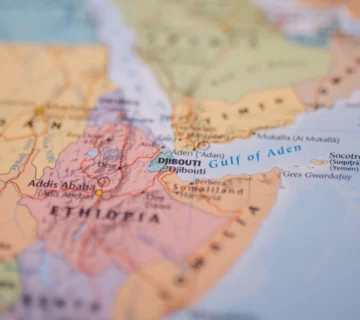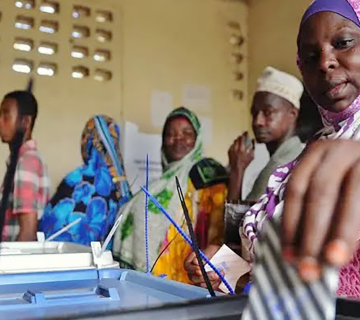On May 6, 1998, the first gunshots rang through the night. The Ethiopian-Eritrean conflict over the scrubby and desolate plains of Badme, a border region between Ethiopia and Eritrea, had begun. Then Ethiopian Prime Minister Meles Zenawi and Eritrean President Isaias Afewerki, brothers in arms in earlier conflicts, broke all communications and cross-border interactions. Two years later, 100,000 had died in a senseless WWI-style trench war where no significant land changed hands.
This May, it has been 20 years since the war started. In December of this year, it will be 18 years since it ended. After the fall of Badme to Ethiopia, intense international mediation efforts culminated in the adoption of the Algiers Peace Agreement on 12 December 2000. In this agreement, A Neutral Boundary Commission (BC) was established and granted with full authority to demarcate the border. When the BC determined that the town of Badme belonged to Eritrea, it instigated an Ethiopian refusal to hand it over, setting the stage for a stalemate that still reverberates across the Horn of Africa.
Not only did 100,000 people die needlessly, the economic, cultural, and political impact was enormous. Thousands of troops still patrol the border, centuries of trade and intermarriage have abruptly ceased, and Ethiopia lost access to Eritrea’s ports. In turn, Eritrea lost its biggest trading partner and retreated into isolationism.
The economic impact of the war cannot be underestimated. According to research conducted by The Economist, a well-known and a strongly informed British newspaper, Ethiopia increased its troops from 60,000 to 350,000. Ethiopia’s military spending rose from $95 million in 1997/98 to $777 million in 1999/2000. Overall, the cost of the war for Ethiopia was $3 billion: enormous (17 percent) for a country with a GDP of $17.7 billion in 1998. Eritrea’s army followed a similar trend when its army increased to 300,000 strong, almost 10 percent of the population. The outbreak of the war saw national conscription rising, despite negative economic impacts of conscription (i.e. loss of workforce, lack of equal opportunities, less education). Both countries lost huge trade and export partners and allocated critical resources from vital public services and developmental endeavors to weapons procurement. Today, the military spending of both countries remains high, with Ethiopia recently buying 200 new tanks and Eritrea residing in a permanent state of war (exact data is unknown).
Culturally, the war has had a devastating effect on the social fabric of the two countries. Both Ethiopia and Eritrea resorted to nationalist framings of identity, territory, and shared history, precipitating conflicting narratives. Neighbors, families, and intermarriages were ripped apart, and are still divided until this date. However, even though the conflict is perceived as an inter-state conflict, it is mostly a conflict between the Tigrinya speaking people of the Eritrean highlands, and the Tigrayans of Ethiopia. According to Awol Allo, lecturer in Law at Keele University in the United Kingdom, the underlying political and economic differences were far from insurmountable. The animosity, rage, scorn, and bitterness between these two movements however made resolution almost impossible.
The impact of the war is, however, most visible in the political domain. Eritrea’s president Afewerki maintains a large standing army and forced conscription under the veil of a permanent war footing. It uses the conflict with Ethiopia to justify suspending the constitution, banning free press and quashing any dissent. This is one of the reasons for Eritrea’s increased isolation over the last one-and-a-half decade. Another reason is Ethiopia’s international efforts to isolate Eritrea from the world by accusing Eritrea of training and arming Islamic extremist factions in Somalia. Traditionally, these factions pose a threat to Ethiopia in the predominantly Somali border regions in the South. In response to these threats, Ethiopia has actively pursued a ‘counter-terrorism’ policy, lobbying for Western support with the United States and the European Union. This policy culminated in the 2006 Ethiopian intervention in Somalia under the banner of the ‘War on Terror’, of which the US was its largest backer. In 2009, Ethiopia played a significant role in pushing for United Nations Security Council Resolution 1907 (2009), stipulating an arms embargo, travel restrictions, and asset freezes.
However, it is also in the political domain that the first rapprochement efforts are now taking place. With the election of Abiy Ahmed as Ethiopia’s Prime Minister on 2 April 2018, comes an end to Tigrayan domination of politics. Prime Minister Ahmed is an ethnic Oromo, and therefore has less baggage than Meles Zenawi, an ethnic Tigrayan had. He now has a unique chance of ending the stalemate and opening a new chapter towards a peaceful coexistence by highlighting the transformative economic and social opportunities peace would bring both sides. And it looks like he is trying to take that chance. Speaking on state television after his swearing-in ceremony on 4 April 2018, Mr. Ahmed called for an end to “years of misunderstandings.” In the same ceremony, he further called for a good relationship with “our African Brothers in general and our neighbors in particular, during good and bad times.”
The international community has also tried to re-approach Eritrea. A UN security council investigating alleged arms transfers concluded that it found no evidence thereof, and advocated to lift the embargo. Additionally, the European Union has sought to re-establish relations with Eritrea to hamper its significant refugee flows. The Guardian reported that in 2015, almost 5,000 refugees were fleeing the country every month, making it the third ‘exodus’ country after Syria and Afghanistan. Furthermore, on 22 April 2018, Donald Yamamoto, America’s most senior diplomat in Africa, visited Asmara, the capital—the first such visit in over a decade. The first signs of Eritrea’s return from isolation are thus visible, but whether they merit any substantial results remains to be seen.
Almost 20 years after the conflict, hopes are high that the economic, cultural, political, and military stalemate comes to an end. To succeed, however, Ethiopia and Eritrea need to bridge two difficult emotional issues: Ethiopia’s retreat from Badme per the Algiers Peace Agreement of December 2000, and in return, access to Eritrean ports; something that Isaias has never shown much interest in the offering. Furthermore, The Economist’s interview with Eritrean refugees on 7 May 2018, demonstrates another problem that might be even more difficult to bridge: Isaias’ use of the threat from Ethiopia to keep smothering democracy and maintaining a huge army. According to one refugee, “making peace would be the end of him. Why would he?” The Eritrean Government seemed to prove this sentiment on Wednesday 16 May 2018, when an Eritrean Ministry of Information statement accused Ethiopian Prime Minister Abiy Ahmed and Sudanese President Omar Hassan al-Bashir of supporting Eritrean armed rebels and proving material support and freedom of movement.
Jules Swinkels is a Visiting Volunteer Research Fellow at the HORN Institute



